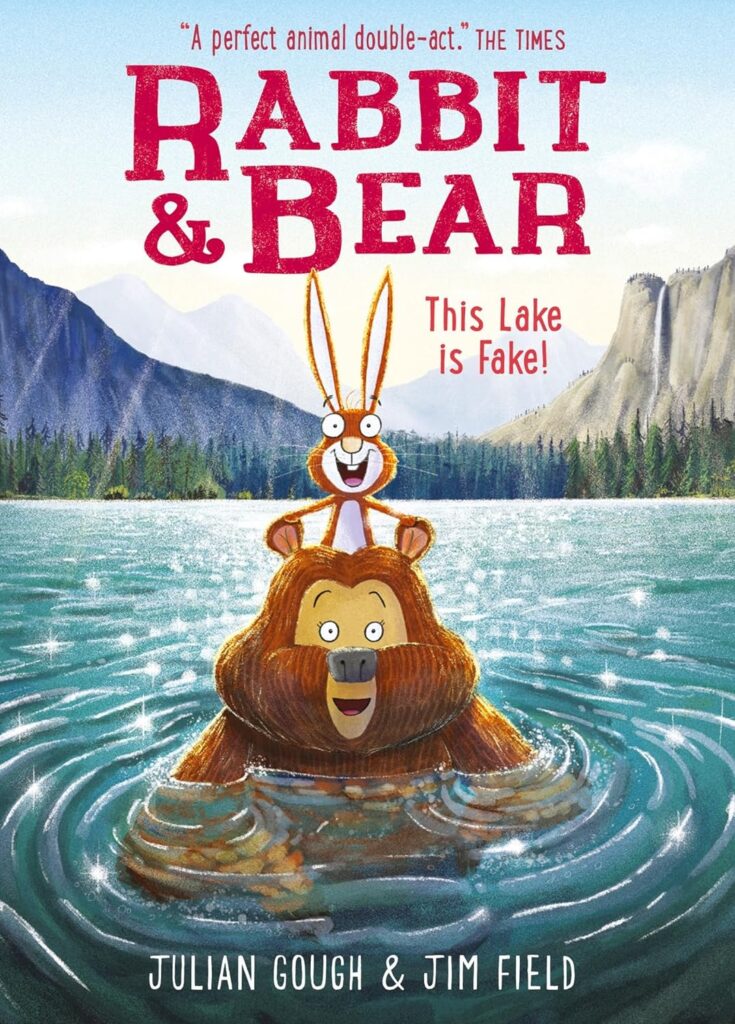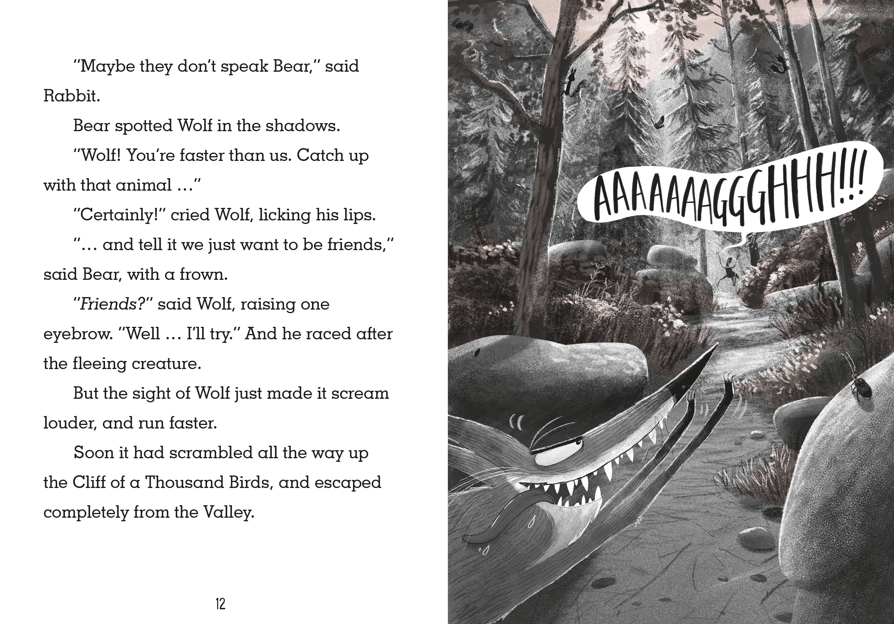A big, cheery hello to author Julian Gough who joins me today in The Reading Realm to talk about THIS LAKE IS FAKE, wittily and wonderfully illustrated by Jim Field!

Before we sit down in The Reading Realm and start chatting about your book, what’s your drink and snack of choice?
Ooooh, good question. Incisive… Yeah, this is the key battleground in any artist’s life; as a writer, if you get the drink and snack wrong, you’re doomed. I used to make an elaborate cappuccino every morning, and, at the first sip, start work. It was my ritual for years. Couldn’t start work without it. In fact, I used to drink absurd amounts of coffee, all day, right up till bedtime, and laugh at people who drank decaf. My attitude was the classic, why would you DO that? Either drink coffee or don’t… But in January last year, my wife Solana gave up coffee and snacks for January, so I did the same – not even because I wanted to; just to keep her company and make it easier for her. And after a couple of weeks without it, I noticed my mood and energy were far more balanced over the day; and I realised that in my normal coffee-fuelled day, I woke up caffeine-deprived, fixed it with coffee, then crashed hard in the evening. Every day was spent on a caffeine rollercoaster. And I hadn’t realised until I stopped! Plus, my sleep improved, which was a BIG win, given that we had a three-year-old at the time (our son Arlo, now four, nearly five), and I therefore hadn’t slept properly in years. So I gave up coffee, and drank water. But after a few months I was REALLY missing coffee, not for the caffeine, but the rest of it; I love the taste, I love the smell, I love the ritual, I love the little breaks to get up and get another mug of it. I experimented with other hot drinks, but they were all meh.
So now I make a big pot of decaf coffee in the morning, and bring it to my office in a flask, and drink decaf all day, and it’s great. It helps that the methods for decaffeinating coffee have improved enormously. Decaf used to suck – the old, crude techniques used would really mess with the flavour – but the new decafs are really good. I drink Altomayo decaf, very tasty. And of course coffee is actually pretty good for you; full of antioxidants and so on. Strip out the caffeine and it’s practically a health drink. So now I AM THAT GUY who drinks decaf all day.
As for snacks… Man, the full story of my relationship with writing-snacks would be a book. Traditionally, it’s bars of chocolate (high-end chocolate! None of yer muck!), but I am trying to convert to fruit, or Greek yoghurt and fruit. (It’s either that, or buy a rowing machine.) Cherries are good with Greek yoghurt. Pour a bit of cream on top, yum… The struggle is real.
Without giving too much away, can you tell us about the new Rabbit and Bear adventure This Lake is Fake, which is illustrated by Jim Field?
Well, Rabbit & Bear have spent all winter in Bear’s cave. So by the time spring comes, the cave is pretty stinky, and Rabbit is in the mood for radical change. Or, as he puts it, “Reality is a cave full of poo, and I refuse to live there!” (This is actually based on my wife Solana’s memories of growing up in Alaska. When the snow finally melted, after all that long winter darkness, it revealed… seven months of frozen animal poop.) He imagines a better world; a Perfect World! When the other animals mock his vision, he’s furious, and goes to look for it, all the way across the lake… So it’s a book about visions of a better world, and about the constraints reality puts on those visions. But it’s optimistic: we can maybe improve the world if we get the balance between vision and practical steps right. (Dreaming too big can get you in to trouble, but so can dreaming too small.) It’s also about the dangers of falling in love with an idea in your head, and then protecting it at all costs. It’s about a lot of things!
It’s also the first Rabbit & Bear book that DOESN’T introduce a new animal to the Valley. It’s very interesting, when you break a pattern: my editor Rachel read the first draft of the book to her kids (well, the 18th draft, but the first one I’d shown her), and they spent the whole book wondering when a new animal would appear, because that was key to all the earlier books. So I had to address that issue at the start of the book, and introduce what looked like a new animal… but it turned out to be a human who was scared of Bear and Wolf, and ran away, leaving behind the mug of hot chocolate and marshmallows that play an important part in the book. I asked Jim to make the human hiker look like me, and he did a marvellous job; I love that I get chased out of the valley by my own characters!

Rabbit and Bear are such a lovely double-act! How would you say they’re similar?
Well they are both aspects of me, really, so they definitely have something in common.
How are they different? What do they each bring to their friendship?
Bear is very Zen; very calm, very accepting. She’s me on a good day, in a good mood. Rabbit is definitely not calm. His mind is incredibly busy, and frequently wrong. To grossly oversimplify both the psychology of the books and the neuroscience of humans, you could say Bear is right brain, Rabbit is left brain. But, although Rabbit gets a lot of things wrong, and often goes too far, he also can have great leaps of insight that, with a bit of work from Bear or Castor, can make the Valley better. So together they make a great team. Really, Bear and Rabbit embody aspects of our own selves, our own minds and bodies, which are often in conflict, but which, when integrated, can perform wonders in the world. So Rabbit & Bear (and Wolf, and Owl, and Castor the Successful Beaver) are a way of making our internal conflicts external and explicit and visualisable. I think kids really get that. I get a lot messages from parents telling me about great conversations they have had with their kids after reading a Rabbit & Bear book. And of course I write each book attempting to solve a problem that I had at that age which I couldn’t solve at the time; so each book is about something urgent and important to kids.
What struck me about this book was that there were moments of hi-jinks and hilarity, which were perfectly balanced with some very touching moments. How difficult is it to strike this balance for you?
EXTREMELY DIFFICULT! I find the Rabbit & Bear books remarkably difficult to write, which one might think odd, given that it’s my job and I’ve been doing it for a while. But with each book I try to do something new, so I’m always writing at the edge of my abilities. I want the reader to feel a full range of emotions when reading, so yes, there are transitions from extremely funny scenes to quite moving ones, which can be tricky to pull off. That said, I think if you know your characters really well, and are true to the characters, then those transitions can work almost automatically. They will feel real.
What are the challenges of writing this kind of book for young readers? What do you enjoy about it?
Well, because they are for 5, 6, 7-year-olds, they are often going to be read to the child by a parent, so you have to write for two completely different audiences. And you want to make sure they both have a good time, which is hard, because in some ways, children of that age are at their most different from adults. But I really enjoy that difficulty. I love technical challenges. I love it when I can pull off a joke that is funny at one level for kids and at another level for adults, and both of them are laughing.
The illustrations by Jim Field are a really integral part of the story. Do you have a favourite illustration from the book? Why is it your favourite?
Jim is a genius. He can do anything, and I really lean on that when I’m writing. When I deliver the book to my publisher, it’s more like a script than a book – there will be lots of notes to Jim suggesting visual jokes, or describing some difficult visual effect that I want him to pull off. This book was particularly demanding because a lot of it happens inside Rabbit’s head – you are seeing Rabbit’s vision of a perfect world, say. Mmmmm, there are so many great images in this book, it’s hard to narrow it down… I love the big two page spread that shows Rabbit & Bear happily swimming underwater, among the fish and the plants. It’s sooooo beautiful, you just want to join them in this weightless paradise. But I also I love Castor the Beaver’s little instruction book on how to build a comfy chair out of sticks! I asked Jim to model it on an IKEA booklet, and he totally nailed it, it’s hilarious, with a little stylised IKEA-style beaver figure and everything. Jim has RANGE! Another of my favourites is the one where Rabbit is remembering what his grandfather told him about hot chocolate, and we see Rabbit imagining his grandfather as a young rabbit, stealing a mug of hot chocolate from a furious farmer. I asked Jim if he could make it gently reference Beatrix Potter’s Peter Rabbit and the furious farmer, Mr. McGregor, and he did and it’s glorious.

I noticed at the end of the story a note about the Guano Islands – what can you tell us about them?
Hah! I love guano islands. They are well worth googling, or asking Chat GPT about, or whatever the smart kids do these days to find out information… Basically, seabirds like to nest on small islands with no predators. And there are lots of these islands, particularly in the Pacific and Caribbean. But if millions of seabirds poop on a small island for hundreds or even thousands of years… well, you end up with a significantly taller island that’s made almost entirely out of poop. Which polite people call guano… On one of the Chincha islands, off the coast of Peru, for example, the guano was over a hundred and fifty feet deep. None of this mattered until the 19th century, when people realised guano was the richest available source of nitrogen, phosphorus, and potassium – all vital for agriculture, to feed rapidly growing populations. (This was before we had invented artificial fertilisers.) So, people started mining it. (Incidentally, imagine working in a poop mine, on a poop island, shovelling away, the air thick with poop dust; unbelievably horrible working conditions.) And it became a HUGE industry. For a while, Peru’s most valuable export was bird poop! It was the oil of its day. In fact, those islands were so valuable, Spain tried to seize them. The competition got so fierce, the US passed a federal law, the Guano Islands Act of 1856, that allowed any American citizen to claim any guano islands anywhere on earth. A bunch of American adventurers went on to claim over 100 islands, rocks, and atolls around the world, to secure America’s vital supply of bird poop. I’ve always loved guano islands, because they are so absurd – people fighting small wars over a giant pile of poop – and so it gave me the perfect metaphor for This Lake is Fake!, and Rabbit’s quest for a perfect world. In fact, I think this book might contain the ultimate poop joke – funny, epic in scale, but also well-researched and grounded in reality. And it gave Jim some amazing images to draw…
Can you give us any clues as to what Rabbit and Bear might get up to next?
Well, they are going to take a little break, and relax by the lake in their comfortable new chairs! The publicity team are calling this Rabbit & Bear’s last book, because that sounds dramatic, but it might actually be true. Jim and I LOVE doing the Rabbit & Bear books, but we have now done six at a very high quality level; I love them, I am intensely proud of them, but they are a huge amount of work, and we both have other things we need to write. (I am writing a non-fiction book about the universe in public, online, called The Egg and the Rock, which you can follow for free, I’ll send you the chapters as I post them: www.theeggandtherock.com ). I only agree to write a Rabbit & Bear book when I have a really good idea for one, and right now, I don’t. So, in a year or two… if I get another great idea… I might give Jim a shout. From a cold start it would then take another two or three years after that to come out, because children’s books take forever. So, for now, yeah, this is it.
Finally, can you describe This Lake is Fake in three words?
Dream! Plan! Act!

